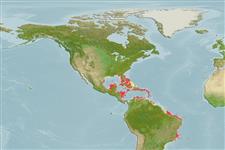>
Syngnathiformes (Pipefishes and seahorses) >
Syngnathidae (Pipefishes and seahorses) > Syngnathinae
Etymology: Micrognathus: Greek, mikros = small + greek, gnathos = jaw (Ref. 45335).
More on author: Jenyns.
Environment: milieu / climate zone / depth range / distribution range
Ecologie
marien rifbewoner; diepte 1 - 21 m (Ref. 52313). Subtropical; 32°N - 33°S
Western Atlantic: Bermuda and the Bahamas to Santa Catarina, Brazil (Ref. 57756); including lower east Florida coast but absent from the Gulf of Mexico except for a single record from Cayo Arcas, Mexico. Dawson (1982) noted that there are two distinct color patterns of this species with no definite intergrades. Some authors are of the opinion that these color extremes represent two different species and should this be true, Dawson stated that Kaup's vittatus has priority over ensenadae with AMNH 7792 documenting the Bermuda occurrence of Micrognathus vittatus.
Grootte / Gewicht / Leeftijd
Maturity: Lm ? range ? - ? cm
Max length : 15.0 cm TL mannelijk / geslacht onbekend; (Ref. 7251)
Korte beschrijving
Morfologie | Morfometrie
Dorsale zachte stralen (totaal): 19-21; Anale zachte stralen: 1 - 3. Possess nine (9) different color phases. Similar to Halicampus zavorensis, it has a short snout (2.7-3.7 in HL) with a continuous and essentially linear median dorsal ridges. Different with H. zavorensis in having 17-18 trunk ridges (vs. 14); 32 - 35 tail rings (vs. 36 - 37); and having 18 - 22 dorsal-fin rays (vs. 22 - 23) (Ref. 52313).
Occurs in pockets of coral rubble (low coral growth on white sand bottom), usually in the vicinity of sea fans (Ref. 5521, 7251, 9710). Ovoviviparous (Ref. 205). The male carries the eggs in a brood pouch which is found under the tail (Ref. 205).
Levenscyclus en paargedrag
Maturiteit | Voortplanting | Paaien | Eieren | Fecunditeit | Larven
Male carries the eggs in a brood pouch (Ref. 205).
Robins, C.R. and G.C. Ray, 1986. A field guide to Atlantic coast fishes of North America. Houghton Mifflin Company, Boston, U.S.A. 354 p. (Ref. 7251)
Status op de Rode Lijst van het IUCN (Ref. 130435)
Gevaar voor de mens
Harmless
Gebruik door de mens
Meer informatie
Leeftijd/GrootteGroeiLengte-gewichtLengte-lengteLengtefrequentiesMorfometrieMorfologieLarvenLarvale populatiedynamiekRekruteringAbundantieBRUVS
ReferentiesAquacultuurAquacultuurprofielKweeklijnenGeneticaElectrophoresesErfelijkheidZiektesVerwerkingNutrientsMassaconversie
Tools
Speciale rapporten
Download XML
Internetbronnen
Estimates based on models
Preferred temperature (Ref.
123201): 25.8 - 28.2, mean 27.4 °C (based on 694 cells).
Fylogenetische diversiteitsindex (Ref.
82804): PD
50 = 0.5039 [Uniqueness, from 0.5 = low to 2.0 = high].
Bayesian length-weight: a=0.00037 (0.00016 - 0.00085), b=3.18 (2.99 - 3.37), in cm total length, based on LWR estimates for this (Sub)family-body shape (Ref.
93245).
Trofisch niveau (Ref.
69278): 3.3 ±0.4 se; based on size and trophs of closest relatives
Weerstandsvermogen (Ref.
120179): Hoog, minimale populatieverdubbelingstijd minder dan 15 maanden (Preliminary K or Fecundity.).
Fishing Vulnerability (Ref.
59153): Low vulnerability (10 of 100).
Nutrients (Ref.
124155): Calcium = 80 [38, 191] mg/100g; Iron = 0.927 [0.464, 1.736] mg/100g; Protein = 18.7 [17.4, 19.9] %; Omega3 = 0.171 [0.088, 0.330] g/100g; Selenium = 15.3 [6.4, 38.2] μg/100g; VitaminA = 45 [13, 164] μg/100g; Zinc = 1.21 [0.73, 1.96] mg/100g (wet weight);
